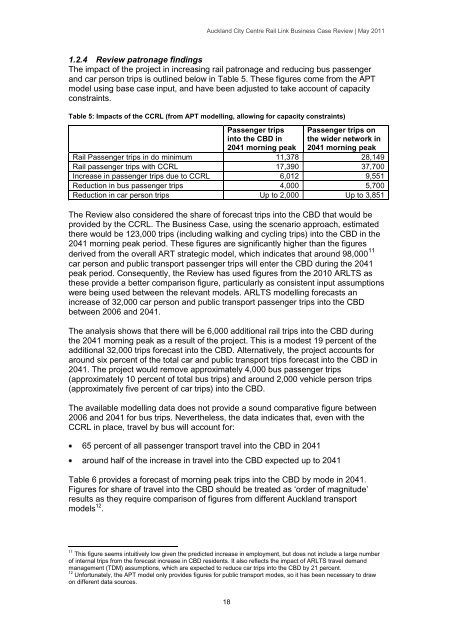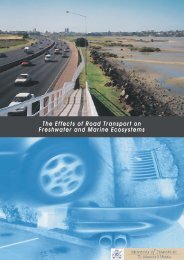Auckland City Centre Rail Link - Business Case Review - Ministry of ...
Auckland City Centre Rail Link - Business Case Review - Ministry of ...
Auckland City Centre Rail Link - Business Case Review - Ministry of ...
You also want an ePaper? Increase the reach of your titles
YUMPU automatically turns print PDFs into web optimized ePapers that Google loves.
<strong>Auckland</strong> <strong>City</strong> <strong>Centre</strong> <strong>Rail</strong> <strong>Link</strong> <strong>Business</strong> <strong>Case</strong> <strong>Review</strong> | May 2011<br />
1.2.4 <strong>Review</strong> patronage findings<br />
The impact <strong>of</strong> the project in increasing rail patronage and reducing bus passenger<br />
and car person trips is outlined below in Table 5. These figures come from the APT<br />
model using base case input, and have been adjusted to take account <strong>of</strong> capacity<br />
constraints.<br />
Table 5: Impacts <strong>of</strong> the CCRL (from APT modelling, allowing for capacity constraints)<br />
Passenger trips<br />
into the CBD in<br />
2041 morning peak<br />
Passenger trips on<br />
the wider network in<br />
2041 morning peak<br />
<strong>Rail</strong> Passenger trips in do minimum 11,378 28,149<br />
<strong>Rail</strong> passenger trips with CCRL 17,390 37,700<br />
Increase in passenger trips due to CCRL 6,012 9,551<br />
Reduction in bus passenger trips 4,000 5,700<br />
Reduction in car person trips Up to 2,000 Up to 3,851<br />
The <strong>Review</strong> also considered the share <strong>of</strong> forecast trips into the CBD that would be<br />
provided by the CCRL. The <strong>Business</strong> <strong>Case</strong>, using the scenario approach, estimated<br />
there would be 123,000 trips (including walking and cycling trips) into the CBD in the<br />
2041 morning peak period. These figures are significantly higher than the figures<br />
derived from the overall ART strategic model, which indicates that around 98,000 11<br />
car person and public transport passenger trips will enter the CBD during the 2041<br />
peak period. Consequently, the <strong>Review</strong> has used figures from the 2010 ARLTS as<br />
these provide a better comparison figure, particularly as consistent input assumptions<br />
were being used between the relevant models. ARLTS modelling forecasts an<br />
increase <strong>of</strong> 32,000 car person and public transport passenger trips into the CBD<br />
between 2006 and 2041.<br />
The analysis shows that there will be 6,000 additional rail trips into the CBD during<br />
the 2041 morning peak as a result <strong>of</strong> the project. This is a modest 19 percent <strong>of</strong> the<br />
additional 32,000 trips forecast into the CBD. Alternatively, the project accounts for<br />
around six percent <strong>of</strong> the total car and public transport trips forecast into the CBD in<br />
2041. The project would remove approximately 4,000 bus passenger trips<br />
(approximately 10 percent <strong>of</strong> total bus trips) and around 2,000 vehicle person trips<br />
(approximately five percent <strong>of</strong> car trips) into the CBD.<br />
The available modelling data does not provide a sound comparative figure between<br />
2006 and 2041 for bus trips. Nevertheless, the data indicates that, even with the<br />
CCRL in place, travel by bus will account for:<br />
65 percent <strong>of</strong> all passenger transport travel into the CBD in 2041<br />
around half <strong>of</strong> the increase in travel into the CBD expected up to 2041<br />
Table 6 provides a forecast <strong>of</strong> morning peak trips into the CBD by mode in 2041.<br />
Figures for share <strong>of</strong> travel into the CBD should be treated as ‗order <strong>of</strong> magnitude‘<br />
results as they require comparison <strong>of</strong> figures from different <strong>Auckland</strong> transport<br />
models 12 .<br />
11 This figure seems intuitively low given the predicted increase in employment, but does not include a large number<br />
<strong>of</strong> internal trips from the forecast increase in CBD residents. It also reflects the impact <strong>of</strong> ARLTS travel demand<br />
management (TDM) assumptions, which are expected to reduce car trips into the CBD by 21 percent.<br />
12 Unfortunately, the APT model only provides figures for public transport modes, so it has been necessary to draw<br />
on different data sources.<br />
18
















